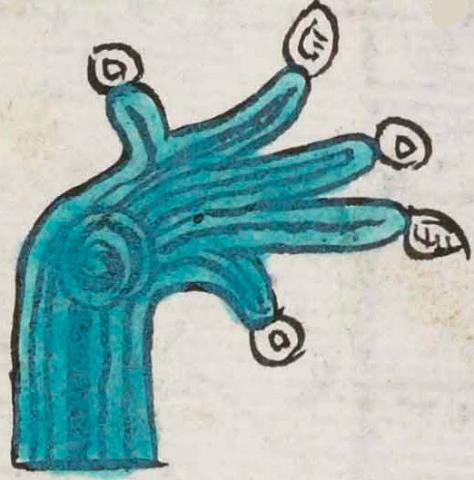Anenecuilco (Mdz24v)
This compound glyph for Anenecuilco involves a flow of water (atl) with a sharp bend. The word nenecuilli stands for something twisted, displaced, or dislocated, which appears to be represented visually by the bend in the water. Counting the bend and the water separately (although they overlap), the result is a compound glyph. The locative suffix -co is not shown visually.
Stephanie Wood
Berdan and Anawalt (The Codex Mendoza, 1992, v. 1, p. 171) point to the verb nenecuiloa over the noun. The water here has some of the usual lines showing current, some of them thick black lines, and at the bend there is a swirl or whirlpool. Beyond the bend, the water disperses into five fingers, each with a turbinate shell or a droplet (or precious stone) at its tip.
Stephanie Wood
anenecuilco. puo
Anenecuilco, pueblo (in the modern state of Morelos)
Stephanie Wood
c. 1541, or by 1553 at the latest
Stephanie Wood
water, river bend, turns, twists, something twisted, shells, nombres de lugares

a(tl), water, https://nahuatl.wired-humanities.org/content/atl
nenecuil(li), something twisted, https://nahuatl.wired-humanities.org/content/nenecuilli
nenecuiloa, to twist back and forth, https://nahuatl.wired-humanities.org/content/nenecuiloa
-co (locative suffix), https://nahuatl.wired-humanities.org/content/co
Codex Mendoza, folio 24 verso, https://digital.bodleian.ox.ac.uk/objects/2fea788e-2aa2-4f08-b6d9-648c00..., image 59 of 188.
The Bodleian Libraries, University of Oxford, hold the original manuscript, the MS. Arch. Selden. A. 1. This image is published here under the UK Creative Commons, “Attribution-NonCommercial-ShareAlike 3.0 License” (CC-BY-NC-SA 3.0).


